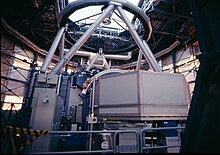Other types

This section is in list format, but may read better as prose. (April 2016) |
Other types of spectroscopy are distinguished by specific applications or implementations:
- Acoustic resonance spectroscopy is based on sound waves primarily in the audible and ultrasonic regions.
- Auger electron spectroscopy is a method used to study surfaces of materials on a micro-scale. It is often used in connection with electron microscopy.
- Cavity ring-down spectroscopy
- Circular Dichroism spectroscopy
- Coherent anti-Stokes Raman spectroscopy is a recent technique that has high sensitivity and powerful applications for in vivo spectroscopy and imaging.
- Cold vapour atomic fluorescence spectroscopy
- Correlation spectroscopy encompasses several types of two-dimensional NMR spectroscopy.
- Deep-level transient spectroscopy measures concentration and analyzes parameters of electrically active defects in semiconducting materials.
- Dielectric spectroscopy
- Dual-polarization interferometry measures the real and imaginary components of the complex refractive index.
- Electron energy loss spectroscopy in transmission electron microscopy.
- Electron phenomenological spectroscopy measures the physicochemical properties and characteristics of the electronic structure of multicomponent and complex molecular systems.
- Electron paramagnetic resonance spectroscopy
- Force spectroscopy
- Fourier-transform spectroscopy is an efficient method for processing spectra data obtained using interferometers. Fourier-transform infrared spectroscopy is a common implementation of infrared spectroscopy. NMR also employs Fourier transforms.
- Hadron spectroscopy studies the energy/mass spectrum of hadrons according to spin, parity, and other particle properties. Baryon spectroscopy and meson spectroscopy are types of hadron spectroscopy.
- Hyperspectral imaging is a method to create a complete picture of the environment or various objects, each pixel containing a full visible, visible near infrared, near infrared, or infrared spectrum.
- Inelastic electron tunneling spectroscopy uses the changes in current due to inelastic electron-vibration interaction at specific energies that can also measure optically forbidden transitions.
- Inelastic neutron scattering is similar to Raman spectroscopy, but uses neutrons instead of photons.
- Laser-induced breakdown spectroscopy, also called laser-induced plasma spectrometry
- Laser spectroscopy uses tunable lasers and other types of coherent emission sources, such as optical parametric oscillators, for selective excitation of atomic or molecular species.
- Mass spectroscopy is a historical term used to refer to mass spectrometry. The current recommendation is to use the latter term. The term "mass spectroscopy" originated in the use of phosphor screens to detect ions.
- Mössbauer spectroscopy probes the properties of specific isotopic nuclei in different atomic environments by analyzing the resonant absorption of gamma rays. See also Mössbauer effect.
- Multivariate optical computing is an all optical compressed sensing technique, generally used in harsh environments, that directly calculates chemical information from a spectrum as analogue output.
- Neutron spin echo spectroscopy measures internal dynamics in proteins and other soft matter systems.
- Perturbed angular correlation (PAC) uses radioactive nuclei as probe to study electric and magnetic fields (hyperfine interactions) in crystals (condensed matter) and bio-molecules.
- Photoacoustic spectroscopy measures the sound waves produced upon the absorption of radiation.
- Photoemission spectroscopy
- Photothermal spectroscopy measures heat evolved upon absorption of radiation.
- Pump-probe spectroscopy can use ultrafast laser pulses to measure reaction intermediates in the femtosecond timescale.
- Raman optical activity spectroscopy exploits Raman scattering and optical activity effects to reveal detailed information on chiral centers in molecules.
- Raman spectroscopy
- Saturated spectroscopy
- Scanning tunneling spectroscopy
- Spectrophotometry
- Spin noise spectroscopy traces spontaneous fluctuations of electronic and nuclear spins.
- Time-resolved spectroscopy measures the decay rates of excited states using various spectroscopic methods.
- Time-stretch spectroscopy
- Thermal infrared spectroscopy measures thermal radiation emitted from materials and surfaces and is used to determine the type of bonds present in a sample as well as their lattice environment. The techniques are widely used by organic chemists, mineralogists, and planetary scientists.
- Transient grating spectroscopy measures quasiparticle propagation. It can track changes in metallic materials as they are irradiated.
- Ultraviolet photoelectron spectroscopy
- Ultraviolet–visible spectroscopy
- Vibrational circular dichroism spectroscopy
- Video spectroscopy
- X-ray photoelectron spectroscopy
Comments
Post a Comment